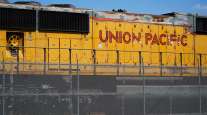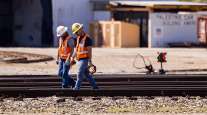Union Pacific CEO Sees Strong Economy Coming Out of Pandemic

[Stay on top of transportation news: Get TTNews in your inbox.]
OMAHA, Neb. — As Union Pacific’s CEO, Lance Fritz has had to find ways to keep the freight moving during the coronavirus pandemic as the economy nearly ground to a halt and then roared back to life. Now he is working to help clear up a major backlog in imported shipments.
In the spring of 2020 — at the height of the restrictions related to the pandemic — shipping volume fell more than 20% before rebounding sharply later that year. Railroads had to cut staff quickly while still making sure they had enough people to cover virus-related illnesses and quarantines before rehiring at a fast pace to handle the return in volume.
Current shipping volumes are nearly even with 2019 signaling that demand is back at pre-pandemic levels and the economy is strong, although it has weakened a bit recently as virus cases surged.
The Associated Press interviewed Fritz, 58, who also serves as the Omaha, Neb.-based railroad’s chairman and president. His responses have been edited for clarity and length.
Q. What do you think of the bipartisan infrastructure plan that is working its way through Congress?
A. The main attribute is it about doubles the spending rate on infrastructure for the next five years — a total of about a trillion dollars. And it includes things that we think are vital to the economy: things like broadband being much more broadly accessible, true infrastructure spend on highways, on power distribution, airports and waterways.
We think all of that supports a more vibrant economy and anything that’s good for the U.S. economy — that helps the U.S. economy grow and thrive — is very good for Union Pacific.

Nati Harnik/Associated Press
Q. How does the overall economy look based on what you hear from railroad customers?
A. It still feels strong. The underlying dynamic is consumers are still sitting on a lot of cash. Borrowing rates are still historically low. There’s still good, strong demand for housing. There is strong demand for automobiles, but automobile production is being impacted by chip shortages. We continue to see decent strength in plastics and steel and things like soda ash that go into very broad parts of the economy and food and refrigerated product.
It does feel like the delta variant has taken the top end of demand off a little bit. It feels firm, underlying demand, but the real heat, the very top end, looks like it has cooled off a touch, but that doesn’t really cause me concern so long as the fundamentals remain in place and they look pretty good right now.
Q. How many shipments is the railroad currently handling?
A. Early in the third quarter and late in the second quarter we were at or better than 2019 levels. More recently we’ve started to dip below 2019 again and that looks like it’s for a lot of different reasons: maybe a little COVID delta variant impact, a little bit of congested supply chains that are retarding some of our customers’ ability to produce and ship. But I think that’s short term. It doesn’t feel like that is long term.
Q. Both Canadian National and Canadian Pacific railroads have made headlines this year with their efforts to acquire Kansas City Southern. What do you think the implications are of the Surface Transportation Board’s decision to reject part of CN’s acquisition plan?

Drivers want good health and education on emerging technologies. Paul Beavers of PCS Software and Dr. Bethany Dixon of Drivers Health Clinic share their insights. Hear a snippet above, and get the full program by going to RoadSigns.TTNews.com.
A. The STB’s language in their rejection of CN seeking a voting trust to acquire the KCS seemed to be pretty negative on future merger and consolidation in the rail industry. It doesn’t look like the STB is going to encourage it.
What we’re focused on is making sure that the process the STB takes whoever through the merger evaluation ... that it’s a fair, transparent process that it includes remedies for the concerns we have and that it holds everybody to the same level of rules and standards going through that process.
Q. Why are there currently so many backlogs in the delivery of intermodal containers of imported goods that come in on ships before being hauled cross country by railroads and delivered to their final destinations by trucks?
A. The intermodal supply chain isn’t just the railroad. We’re the middle miles. The supply chain goes all the way from factories in let’s say Asia to a distribution warehouse in Chicago somewhere.
Where we are seeing real bottlenecks right now is at the distribution end where there is not enough capacity to take the demand of boxes and get them off our intermodal ramps and into a distribution warehouse. That’s both labor at the distribution warehouses and truck capacity.
That will get remedied when every single element of the supply chain has enough capacity to handle the full volume of demand. Right now that’s not the case, and that’s why you see ships parked outside of Long Beach and Los Angeles.
Want more news? Listen to today's daily briefing below or go here for more info:




